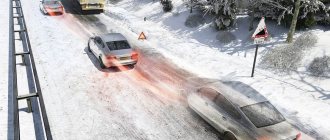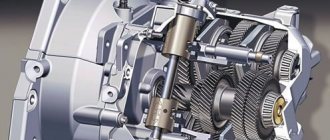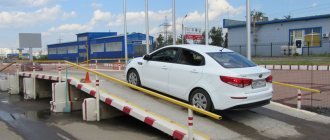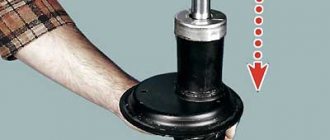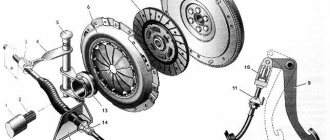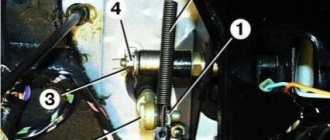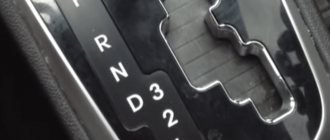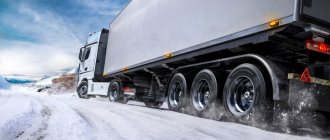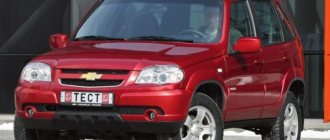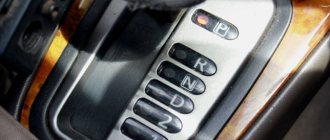Pros and cons of this maneuver
If you have never braked your car in this way, then you need to learn what it means to brake with the engine under normal weather and road conditions so as not to panic in an emergency situation. As I already said, this method helps to avoid skidding when braking in icy conditions. In this case, the wheels are not blocked by the brake pads, as happens during normal braking. The control system is not blocked, and the machine becomes more stable.
The speed reduction occurs quite smoothly.
But it is always worth considering that with this method the braking distance is much longer. It is difficult to say definitively whether engine braking is harmful. We can say that a clear plus is safety. The downside is the duration and smoothness. Those. In no case will engine speed reduction be an emergency, and this must be taken into account. Another important nuance is that when you decided to carry out such a maneuver, no one except you knows about your intentions. While the brake lights at the rear of the car turn on when you press the brake pedal, this does not happen when you apply engine braking. This means there is a possibility of an accident. Many people say that this method allegedly increases wear on the transmission and engine. It's really not that scary. After all, this method is not used very often to damage the vehicle. The main thing is more practice and the ability to foresee a situation in which it is appropriate to use a similar method of reducing speed.
Slow braking on manual
My first car was simple. It had a 5 gear manual transmission. I learned how to brake with a manual engine from a friend of mine who got behind the wheel purely by chance. In short, the movement pattern should be like this:
- Release the gas pedal.
- Depress the clutch pedal.
- Turn off overdrive.
- Engage downshift.
- Release the clutch pedal and gradually reduce the speed.
Do not rush to quickly switch from high speed to low speed.
If your tachometer now shows 2000 rpm, then when you turn on the reduced speed the engine will scream and this is really bad. The ideal switching speed is 1200 – 1500 rpm. As soon as we change the gear to a lower one, the tachometer needle will rise to 2 thousand revolutions, and this is a more normal option. In general, you need to train. Much also depends on the engine size. This is more than a detailed sequence of movements. This does not have any negative impact on the car. Once again, I advise you to try this method on a dry and well-known road.
It is very important to understand the braking distance of the car and its general behavior with this method. By the way, sometimes you can use minor short presses on the brake pedal
Such movements imitate the actions of ABS and have also helped me out more than once on slippery roads at short distances to the stop line.
What about automatic transmission?
A little later I bought myself a car with automatic transmission. For a long time I could not understand how to brake with an automatic engine. We can say that the situation here is more complicated, but this is also possible. An automatic transmission does not respond to braking as well as a manual transmission, and you have to use the service brake more often. It matters how old your machine is. On older versions there are restrictions on switching speeds. In newer versions, it is ideal to use semi-automatic mode, this will allow you to slow down naturally and switch to a lower gear. You must understand that only reducing the speed will allow you to switch to a lower gear. There is no other way to do this. In order to get used to the machine and understand how to use this method on it, it takes more time and skill. I didn’t immediately manage to figure out at what speed I could start slowing down to avoid unnecessary skidding.
But over time, the skill came and I realized that for an automatic machine, when trying to reduce the speed with the engine, it is extremely important not to press the gas pedal at all
As a result, I can say that it is not very difficult to figure out how to properly brake with an engine in a slippery situation. You need to remember the scheme for changing from an upshift to a downshift, under no circumstances squeezing the brake sharply and keeping in mind the long braking distance of the car. And one more nuance - no matter how much you want to stop abruptly, it is strictly forbidden to switch directly to first gear, because skidding is simply guaranteed. Plus, such a jump will be harmful for the engine. I mean switching on a manual from 3rd gear to 1st or 4th to 2nd at high revs. Return to top
https://daciaclubmd.ru
Driving Rules
Manual transmission lever
Most drivers who started their driving journey with an automatic transmission simply cannot “switch” to a manual transmission. What can we say about novice car enthusiasts? But after a person tries to drive with both types of gearboxes, he will have no doubt that driving a car with a manual transmission is much more pleasant.
In turn, by switching from a manual transmission to an automatic transmission, you can feel greater ease in driving the car, but driving itself may seem boring without changing gears. We invite you to familiarize yourself with and use the basic rules for driving a car with a manual transmission. Anyone can understand how to drive a car. Below are driving instructions for dummies.
How to start a car and start driving
So, let's start driving a car with a manual transmission:
Depressing the clutch before changing gear
- Adjust the seat position so that you can easily depress the clutch pedal, which is located on the left, next to the brake.
- Then set the manual transmission lever to neutral, squeezing the clutch in advance. This is done before starting the engine. Attention! Switching modes without pressing the clutch pedal is unacceptable! By doing this regularly, you expose your car's manual transmission to failure.
- Now you need to start the engine by turning the key on the starter.
- It is advisable to warm up the engine to operating temperature. If you start driving in winter, then for the first two or three minutes, while the engine warms up, you do not need to release the clutch pedal. So, the frozen transmission fluid in the box will warm up faster.
- If you start the car with the car in gear, expect it to jerk at first, but not start. Do not do this in a parking lot or if there are other vehicles in front and behind you, otherwise it will lead to a minor traffic accident.
- In order for the vehicle to start moving, you need to lift your left foot from the clutch and press the gas with your right. This is done at a time when the engine speed decreases. You need to learn how to properly balance the clutch and gas pedals. You may have to practice several dozen times before you find the “golden mean”. To prevent the car from stalling while releasing the clutch, the engine must have enough revolutions - to increase them, press the gas. But don’t be too zealous, because as a novice driver, it’s too early for you to master a sharp start.
Driving a car with manual transmission
Remember! When the engine is turned on, the vehicle will not move in two cases: if the manual transmission is in neutral and when the clutch is fully depressed.
How to brake correctly
Proper braking on a manual transmission involves driving at speed until the stop is complete. Even in driving school they teach that coasting (in neutral mode) when driving a car must be completely excluded from everyday driving. Especially in the winter on snow or wet asphalt.
We recommend: Express engine oil change: why it can be dangerous
Engine braking. If you need to slow down the engine and stop in severe weather conditions (ice or rain), you need to do the following:
- release the gas pedal;
- slowly press the brake pedal: forget about the sharp brake when driving on ice - the car will skid;
- before stopping completely, quickly depress the clutch, otherwise the engine will stall;
- Now you can put the gear in neutral and release the pedals.
Braking in dry weather. If the driver needs to brake sharply when driving on dry asphalt, the following actions must be taken:
- first release the gas pedal completely;
- then press the clutch pedal to the floor;
- then press the brake until the car stops;
- when the car is stationary, turn on neutral and take your feet off the pedals;
- do not forget to put the vehicle on the “handbrake” (parking brake).
Car skidding in the snow
Smooth car braking. In order to slow down or slow down, you need to:
- release the gas pedal;
- Without touching the clutch pedal, briefly press the brake. This needs to be done very smoothly and carefully: imagine that you are communicating with the fair sex and are afraid of blurting out too much. It’s the same with a car - you need to slow down gently;
- When the speed is reduced, depress the clutch and engage the desired gear.
Gear shift rules
To correctly switch manual transmission modes, you must not forget that you should press the gas smoothly. Otherwise, the vehicle will jerk forward sharply and slip. Such driving will not only cause increased wear on the tires, but will also increase the load on the engine, which is not necessary. You can continue driving in first gear up to 20 km/h, after which you can smoothly depress the clutch, shift the manual transmission lever to second speed and add gas.
After switching to second, you need to drive for some time so that the driver feels confident and comfortable while driving. You must learn to feel the dimensions of the car on the sides and control the situation on the road using the side rear-view mirrors. Repeat the movement in second gear several times to hone the skill of starting a car and switching manual transmission modes. If you are already doing this on “automatic”, then it’s time to turn on the third speed.
Rear wheel slip
The principle of switching to third gear is identical to second gear, the difference is that when accelerating, you need to reach a speed of 40-50 km/h. The fourth and fifth gears are switched in exactly the same way, only here you need to accelerate more. Refer to the tachometer if the car has one. It is optimal to switch speeds at 2,500 - 3,000 rpm.
Consider a few rules:
- when switching to third, fourth and fifth gears, the clutch must be released faster than when starting to move and when switching from first to second speed;
- if the driving speed is high, then the braking distance will be longer;
- including fourth gear mode, the car must be accelerated to at least 60 km/h;
- including fifth gear, the car speed should be about 90 km/h.
Of course, for each car there are instructions for switching manual transmission modes. The above data are averages.
How to properly enter a turn with manual and automatic transmission Errors and tips
Manual transmission smooth engine braking before traffic lights and turns
Approaching the turn
Here you should gradually slow down to the most optimal speed for cornering; Entrance; Passing, pay attention to the need to control the direction of movement; Exiting the turn. Accompanied by the return of the steering wheel to a straight position; operation with gas may vary on different types of drive.
- As we have already understood, passing a turn begins with preparation, or rather with deceleration. Mechanically, this can be done in three ways. Simply slow down, apply the brakes, and apply engine braking. If everything is clear with the first 2 points, then it makes sense to examine the last one in more detail. Essentially, engine braking involves shifting to a lower gear, which results in a decrease in speed. It is used when the road is quite slippery; in such conditions, using the braking system will lead to loss of controllability;
- Entering a manual turn must be done with constant traction. This will prevent you from losing control of the vehicle;
- The passage must be accompanied by control of all parameters. The speed should remain stable, or at least decrease slightly;
- Corner exit will depend on the type of drive. Rear-wheel drive is more sensitive to gas operation. If you start increasing the speed at this moment, you may end up skidding to the inside of the turn. On the contrary, on front-wheel drive, it is recommended to slightly increase the speed to stabilize the trajectory.
AutoFlit.ru
Cases when engine braking is indispensable
Such cases include situations when driving a car in neutral is strictly prohibited - driving from the mountains, along mountain serpentines. Without engine braking and repeated downshifts, there is a risk of overheating the brake system, increasing the braking distance by a quarter, as well as the risk of loss of control caused by severe overheating of the brakes.
It is important to remember that neutral speed is designed solely for the driver to change gears and to allow the engine of a stopped car to run, and not for use while the car is moving. Neutral is also designed to smoothly start the vehicle and maintain engine operation while the vehicle is stopped.
When reducing speed, engaging lower gears increases your driving safety.
When the speed decreases, engaging lower gears increases traffic safety. It is recommended to downshift when the tachometer needle drops to 2,500 rpm, if you have a car with a naturally aspirated gasoline engine, to 2,000 rpm. — with a car with a turbo engine, up to 1,500 rpm. - for an engine running on diesel fuel. These are the lower average limits. You should proceed from the maximum torque values of a particular car brand when changing gears. So, we mentioned above the need to engage a lower gear to increase stability in the turning arc.
ABS and braking
How to start with a manual transmission correctly
Our inexperienced domestic motorists began to encounter this system more and more often. In order to brake correctly with ABS, you must become familiar with the principle of its operation.
Working principle of ABS
The main task of this system is to prevent any of the wheels from locking when braking. Thanks to ABS, there is almost no friction between the tire and the road. And if it does occur, then its force is evenly distributed by the system between all wheels.
A completely locked wheel is at rest relative to the road surface. Therefore, friction acts on the entire surface of each tire. If it is unevenly distributed between the four wheels, a difference in friction force occurs and the car skids or rolls over.
On the inside of the hub there are special teeth that transmit their movement to a special ABS sensor. If the rotation speed of any of the hubs becomes slower or one of the wheels stops, ABS slightly reduces the pressure in the brake system and then increases it again.
Braking
- To stop a car equipped with ABS, you just need to hold down the brake pedal. The system itself will distribute the required pressure across all 4 wheels.
- In car models equipped with a manual transmission, to slow down, you must simultaneously press the brake pedal and clutch to exclude the engine from braking. Deceleration with the participation of the motor is carried out by reducing the speed transmission of the drive wheel.
- When ABS is operating, a “crunch” of the system is heard, and the driver’s foot feels a twitching of the brake pedal.
- When using the anti-lock braking system, remember that it stops working at speeds below 5 km/h.
- You need to understand that braking on turns using anti-lock is not only ineffective, but also unsafe. The system will not be able to cope with the redistribution of this level of load between the wheels, and the car may skid or roll over.
When braking using ABS on uneven and heterogeneous surfaces, its efficiency coefficient is significantly reduced. This manifests itself in a strong increase in braking distance.
What's happening?
When engine braking, the crankshaft, the inertial rotation of which is caused by the rotation of the wheels, and therefore the speed of the vehicle, experiences loads from the engine that weaken this rotation. Simply put, the car begins to brake when the rotation of the driveshaft through the engaged gear causes the crankshaft of the engine (turned off or running at low speeds) to rotate, which, through a mechanical load, dampens the rotation of the driveline. The opposite situation is created when it is not the engine that transfers mechanical energy to the cardan drive, but, on the contrary, the rolling wheels rotate the engine through the cardan drive. Thus, through mechanical losses (from the forced operation of the crankshaft and parts of the cylinder-piston group), a reduction in the rotation speed of the cardan transmission and, consequently, the speed of the vehicle is ensured. Thus, the car, in essence, brakes.
Features of engine braking
How to change gears correctly on a manual transmission
This type of braking can be used in a number of situations:
- It is necessary to stop or brake on a steep or long descent,
- The brake pedal has failed.
What does engine braking mean? In fact, this method should be called braking not by the engine, but by using the gear lever. Although, if we evaluate it in terms of the influence it has on the mechanisms of the machine, in this case the engine is mentioned here quite rightly.
To start engine braking, you need to release the accelerator pedal, then you need to alternately switch from higher speed gears to lower ones.
Please note: these actions must be performed one by one. If you shift from 5th gear directly to 1st, you will immediately lose control of your vehicle.
In this case, the car will skid, and the engine may break. It will be a great success if on your way in this case there is a flat, clean field, and not an oncoming collision with rushing cars, or another equally dangerous obstacle.
If you go from 5th gear directly to 1st, you will immediately lose control of your vehicle. In this case, the car will skid, and the engine may break. It will be a great success if on your way in this case there is a flat, clean field, and not an oncoming collision with rushing cars, or another equally dangerous obstacle.
Important nuances
Ideally, the car should drive without jerking, moving from one speed to another. When buying a used car or a new car, all buyers always look at such a detail as the type of gearbox used.
Do I need a power of attorney for a trailer for a car:
Category: Registration
Objectively, the easiest car to drive is considered to be an automatic transmission.
But it is important to understand that there are a number of types of gearboxes, and not a simple division into manual and automatic. We recently studied with you the features of sequential gearboxes, and also got to know the variator in more detail
I advise you to re-read and update your own knowledge regarding automobile gearboxes. In terms of reliability and durability, classical mechanics still firmly holds the first position.
When used correctly, the car can accelerate quite quickly, squeezing the maximum out of the installed engine. But when the engine is powerful, and the driver does not know how to shift correctly, then no amount of horsepower will help you.
One general principle applies to all manual transmissions. It consists in the fact that first the clutch is depressed, then the speed is switched, after which the clutch pedal is lowered.
How to brake correctly in front of a traffic light
On a hard surface in dry weather, before a traffic light, it is more profitable to brake by simultaneously pressing the brake and clutch
The manual braking rules taught by driving schools are as follows:
- The vehicle must move while the gear is engaged.
- The driver constantly changes gears according to the speed of the car in order to be ready to quickly perform the necessary maneuver.
- Only to stop when the car is moving at a speed of 5-10 km per hour, the clutch with the brake is depressed to stop the car.
Practice shows that few drivers use the correct method of engine braking, since they get tired of frequent downshifts, fuel consumption increases, and the gearbox wears out faster. Of course, on hard surfaces in dry weather it is more profitable to brake by simultaneously pressing the brake and clutch.
Why does a car slow down when the engine brakes?
This method of braking involves a certain resistance of the motor to the inertial load, which tries to increase the crankshaft speed. In other words, the engine begins to brake the car at the moment when the car is moving at a certain speed with the gear engaged, but at this time the fuel supply is stopped or minimized.
Cutting off the fuel supply means that the engine is no longer sending energy to the transmission. It turns out that the transmission begins to transfer the load to the engine from the wheels rotating by inertia, the crankshaft speed decreases and the car loses speed, that is, it slows down with the engine.
Next, it is necessary to consider those features due to which braking is carried out. It’s worth starting with the fact that a noticeable deceleration of the car during engine braking is not always possible. Pressing the gas pedal increases the fuel supply, resulting in an increase in crankshaft speed (the engine spins up). The released pedal means that the speed drops.
Without going into too much detail about the design of the transmission, we note that the task of the gearbox is to distribute torque to the wheels. To put it another way, the gearbox “doses” the energy that the engine gives, depending on the selected gear.
Driving in lower gears (1-2-3 gears) involves transferring maximum energy to the wheels, but the car will not accelerate to high speeds. Engaging in a higher gear (4-5-6) will allow the car to go faster, but the intensity of acceleration drops, since the box will not allow as much energy to be transferred to the wheels as was transmitted at lower speeds.
Higher gears (5-6) accelerate the car much more weakly, often only allowing you to maintain the previously acquired speed of the car. When driving in high gear, significant inertial forces are present, as a result of which the resistance of the internal combustion engine and gearbox itself is specially reduced by the designers to a minimum.
It turns out that dynamic acceleration is possible only in lower gears. If you release the gas at this moment, then the resistance to inertial movement will be great. If you stop pressing the accelerator in higher gears, the car will not slow down intensively, since the resistance is low.
How to avoid burning out the clutch on a car
A burned clutch is a common technical problem faced by inexperienced drivers.
A burned clutch is a very common technical problem that inexperienced drivers have to deal with. This usually happens when the flywheel rotation speed is too high when the driven disk is mated. As a result, contact is impossible due to increased speed, as a result of which the surfaces instantly overheat and lose their properties.
When the car begins to roll back, it is important to understand that the problem is not so much in the gas pedal being pressed poorly, but rather in the clutch not being released enough. As a result, the newcomer presses on the gas by mistake, the engine literally bursts from unrealized power, after which the clutch pedal is released, and this causes the unit to burn
General concept of a car
Cars have long become an integral part of our lives. They serve well in demanding situations, especially when it comes to long-distance transport. Today, all over the world, such a vehicle is much higher in popularity than airplanes or trains.
Serial production of machines is due to the fact that in the 21st century, technology allows this to be done without any special worries. But once upon a time the car was a real curiosity, and it took a lot of time and effort to develop it. However, each time they became more and more preferable, and their image was improved. The very peak of the dawn of the automobile industry, so to speak, came in the middle of the 20th century, when the world, having recovered from the war, embarked on the path of the industrial era. It was during this period that “giant corporations” began to appear, which would annually roll out millions of cars from their assembly lines. We will not go into details of the names of these industrialists, in order to avoid advertising, but let’s just say that they are well known to all of humanity.
A car is a broad concept; it includes not only a passenger car (with right- or left-hand drive), but also a bus, truck, trolleybus, SUV, racing car, etc. All of them come in large and small sizes, with petrol or diesel engine. A machine is, first of all, a constructed model consisting of thousands of different parts. Among them, some are more significant, and some are less productive. Even an experienced professional with a good understanding of machines cannot always say what the specific purpose of a single part is. A passenger car consists of several parts - the body, engine, electrical equipment and chassis. Some will not agree with this reasoning and will say that a few other important elements can be added, but what we have already said will be quite enough. The body is a kind of interior. People are placed there, seats are located, etc. It’s all a frame structure. An engine is needed to propel a car. The most common one in this regard is the internal combustion engine.
Electrical equipment - it is designed for various functions, without which an ordinary car would not be able to operate normally, and these are the control panel, light, alarm, heating and many other similar means. Well, and finally - the chassis, in a word, they serve to transmit torque from the engine to the wheels. In general, this is a very complex component and it is represented in three actions: the chassis, the vehicle control mechanism and the transmission. As for the last designation, it is in it that a particularly important unit is located, the name of which is the gearbox. Its main purpose is to change the engine torque curve on the drive wheels of the car. Selecting a gear under driving conditions is one of the important points along the route. The gearbox can be of several types, but there are only two main ones - manual and automatic. If with the second everything is more or less clear, even by virtue of the name alone, then it is better to decide seriously on the mechanics, and in order to indicate its sequence we will consider all this in more detail.
Extreme braking
It is used mainly in critical cases, for example, a child or a pedestrian runs out onto the road (it could also be an animal - cats and dogs often run out on the sly) or the car in front suddenly stops,
There is nothing complicated here, only your reaction is needed. You need to press down the clutch and brake pedal as hard as you can at the same time. The car should stop abruptly, then shift out of gear. I would like to add that sometimes cars stop abruptly or simply in an extreme manner, so you (especially novice drivers) must be very careful while driving.
Video version
And the last way to stop, in our article:
We have it separately, it sounds like this: -
Which is braking or gear shifting first?
I’ll dwell in more detail on the question “what first: do we brake and then switch, or switch and then brake?” There are different opinions on this topic, and many racing drivers - professionals in their field - agree that you need to brake first and only then shift. In particular, Mikhail Gorbachev, whom I respect, writes about this in his books.
In my opinion, not everything is so simple, I will make some clarifications, after which everything will fall into place. Once again we will answer the question: why do we shift gears down when braking? In order to maintain the engine speed we need and not lose engine traction
. Why is engine thrust needed when braking? Read more above, but here I will once again briefly describe the main points:
- for the possibility of intense acceleration to avoid a collision;
- for the possibility of engine braking to avoid loss of controllability;
- to create an anti-lock effect on the brakes. This is true for older cars without ABS, and I will not consider this issue here. Let me say briefly: if you have such a car, engage lower gears and you will brake even safer.
There is one more point - a sporting one:
to enable intense acceleration out of corners and reduce time on the race track.
Brake at races
It is this last point that is most important for racing driving and is why racers always downshift when braking.
At the same time, they switch not at medium speeds, as I recommend for city driving - at 2500 rpm, but at high speeds: so that after switching, the tachometer needle rises to the red zone. And the car in racing mode on the straight line goes in intense acceleration mode, the tachometer needle is in the speed range and by the end of the straight line it often reaches the red zone. It is clear that in this situation the driver cannot and should not shift before braking, since in this case the tachometer needle will go off scale. First he brakes, the revs drop from the maximum, say, from 7000 to 5000, after which he shifts down the gear, raising the revs again to the maximum - 7000 rpm in our example.
Switch in the city
As for city driving, in normal modes the tachometer needle is usually in economy mode: 2000-3500 rpm. When accelerating, it reaches the upper limit of the zone - 3500 rpm, and during steady motion, the optimal speed is 2500 rpm. Now remember that it is advisable to switch down when the tachometer needle reaches exactly 2500 rpm. It turns out that in such a situation - first switching, then braking.
Sometimes they object to me, they say, while you switch, time will pass and you will lose braking. Friends, we are not at the races. If you need to hit the brakes 100 meters before a traffic light, why can't you predict this in advance and start downshifting 110 meters before? And after switching – just 100 meters before stopping – go to braking, what’s so difficult? Use your defensive driving skills!
You can, of course, slow down first, but we will immediately lose speed, the tachometer needle will go down beyond 2000, then what is the point in switching at all? We switch not for the sake of physical exercises for our arms and legs, but for the sake of maintaining the engine speed we need. This means that we must do this in a timely manner and be guided by the tachometer readings, and not by the moment we press the brake pedal. If the revs are high and it’s too early to shift, brake and then shift. If the revs are already low and it’s time to shift, shift and brake then
. Downshifting and braking are two independent processes; they can exist both together and separately from each other. The driver does not have to touch the brake pedal at all, but only brakes with the engine and downshifts. Then the phrase “first press the brake, and then switch” makes no sense at all.
So, friends, be flexible and use certain driving techniques wisely.
The next article contains specific braking techniques and recommendations for their use.
https://kaminsky.su
How to avoid jerking when downshifting?
There are two options.
Smooth clutch release
The simplest, but not the most effective way to smooth out the jerk when downshifting is to release the clutch pedal for a long time. How long? 2-3 seconds until the engine smoothly picks up speed. The sequence of actions using the example of switching from III to II gear is as follows:
1. Accelerate to 50 km/h in 3rd gear. The tachometer will show about 2500 rpm.
2. Release the gas pedal, simultaneously depress the clutch pedal and at the same time move the gear lever to neutral.
3. Hold the lever in neutral for a split second.
4. Shift the lever into 2nd gear while simultaneously starting to release the clutch pedal.
5. When the pedal reaches the moment of “grabbing” (approximately halfway through its travel), hold it in this position for 2-3 seconds and watch the tachometer. The needle will begin to rise smoothly up to approximately 3500 rpm.
6. When the arrow stops at these revolutions, release the clutch pedal all the way, if necessary, gradually adding gas.
What's good about this method? It's easy to do. What's bad? This switching takes a long time, plus the clutch discs wear out. After all, the equalization of engine speed occurs due to the sliding of the clutch discs relative to each other. What is popularly called “burning the clutch.” And the switching still can’t be called perfectly smooth. In general, from my point of view, this method is suitable for novice drivers. As they say, simpler and at least somehow.
Peregazovka
There is a more complex, but also more effective way to smooth out the jerk when downshifting. It was called "regasification". The bottom line is that the driver increases the engine speed before engaging the gear. And then the engine no longer needs to spin up; once spun up, it gently “accepts” the downshift. How can a driver increase engine speed? It’s very simple – press the gas pedal. Here is the sequence of actions using the example of changing from 3rd to 2nd gear:
1. Accelerate to 50 km/h in 3rd gear. The tachometer will show approximately 2500 rpm.
2. Release the gas pedal, simultaneously depress the clutch pedal and at the same time move the gear lever to neutral.
3. Release the clutch pedal and at the same time briefly press the gas pedal (actually, re-gas) so that the tachometer needle rises to approximately 4000 rpm.
4. Depress the clutch pedal again.
5. Shift the lever into 2nd gear, simultaneously starting to release the clutch pedal and, if necessary, gradually adding gas.
After switching, the tachometer will show about 3500 rpm. Why then do you need to throttle to 4000? In order to reserve an extra 500 revolutions in case of their loss, because switching takes a certain time, during which the needle will fall a little. Although, when you bring the technique to automaticity, everything will happen so quickly and accurately that you won’t need to “lay in” anything.
How to brake properly before a turn
Skidding on corners is not uncommon and occurs due to the poor condition of the roads under the front and rear wheels, as well as the slope of the road
Skidding on corners occurs for various reasons, which include, for example, the unequal condition of the road surface under the front and rear wheels, and the slope of the road. Skidding and skidding of the car also occur due to non-simultaneous blocking of the wheels. It is much easier to stop a skid at the very beginning, when the car has not yet left the trajectory.
If a skid has already occurred, you should follow a few tips:
- Do not press the brake pedal under any circumstances - this will complicate the situation as the car will become uncontrollable.
- Don't use the clutch pedal either - it doesn't make any sense.
- The situation is complicated by abruptly releasing the gas pedal.
- If you have a rear-wheel drive car, gradually reduce the engine speed.
- If you are the owner of a front-wheel drive car, increase the speed to stop the skidding using the traction of the steering wheels.
- Turn the steering wheel only in the direction of the skid: the rear of the car skids to the right - turn the steering wheel to the right quickly, but without sudden movements. Moderation in steering control is good here.
When the gear is in neutral, the control of the car is not affected by the gas pedal. Consequently, engaging neutral gear while cornering will lead to dire consequences - loss of control over the car. It should also be taken into account that even when, for example, fourth gear is engaged, at a speed of 60 km/h, the tachometer shows less than 2,000 rpm. With such weak engine thrust, engine braking will be very ineffective. Only effective engine braking can stop a car from skidding and an accident, provided the engine thrust is 3,000-3,500 rpm. in third gear at a speed of 70 km/h.
Slippery inclines are easy to overcome if you select the right speed and gear in advance. It is inconvenient to change it on the climb itself. Front-wheel drive cars often slip on slippery slopes. You can try driving up the hill in reverse.
Engine braking on an icy downhill slope will be successful if 2nd gear is engaged in advance at the beginning of the downward movement. Pressing the brake turns the car into a sled. Sharp turns of the steering wheel will also not help control the car - it will drive straight, despite the driver's best efforts to turn to the side.
https://youtube.com/watch?v=XBFI6mwKo1w
Increasing tire grip improves the situation slightly. The use of snow chains, studded tires, and special winter tires can make driving on a slippery road surface somewhat easier. If you brake the engine smoothly, measuredly and softly, the car will gain stability and the likelihood of such a nuisance as skidding will be reduced.
Driving a car on ice is somewhat simplified by modern ABS - an anti-lock braking system that prevents the wheels from completely locking and losing control of the car. Before the invention of such a device, drivers could rely only on their skill when skidding. The operation of ABS simulates intermittent pressing of the brake, which prevents the wheels from locking. It is worth considering that ABS does not provide precise control, so it is better to brake in advance to enter the maneuver at the correct speed.
Racing braking
The rider first brakes, reducing the rpm to 5,000, and then shifts into a lower gear, while raising the rpm
Shifting gears down is a technique that racers always use when braking, and they do it not at 2500 rpm, as drivers do in the city, but at high speeds, when the tachometer needle is in the red zone. Engine thrust during braking is needed to speed up the exit from a turn and pass the route as quickly as possible. Therefore, the driver first brakes, reducing the revs to 5,000 so that the tachometer needle does not go off scale, and then shifts to a lower gear, while raising the revs.
Good advice
I’ll give you a few more general recommendations, and also touch on the topic of at what speed you should switch if the driver prefers to navigate by the tachometer. This is true for beginners who simply do not yet know how to rely on the sound of the engine.
- Always try to keep your foot on the designated resting area. Do not hold it directly over the pedal;
- Adjust the position of the chair relative to the box to suit you. When shifting, you should not reach for the lever;
- When performing actions with the box, be sure to move your left hand to the center of the steering wheel, to its top point. This will allow, if necessary, to perform an emergency maneuver with only one hand;
- Initially, it is recommended to switch using the tachometer;
- If you have a diesel engine, then the transition from gear to gear is carried out at 1500-2000 rpm;
- For gasoline engines, the current range on the tachometer is 2000-2500 rpm.
These are really important recommendations that should be strictly followed.
Everything comes with experience and practice. But competent work with a manual transmission allows you to significantly save fuel, preserve the integrity of the transmission components, engine and pedal assembly, and also use every horsepower to the maximum.
What secrets of manual shifting do you know? Share in the comments.
Thanks to everyone who reads us! Subscribe, leave reviews, ask questions!
( 18 ratings, average: 4.61 out of 5)
In the last article I wrote how to shift up gears correctly. It's time to move on and discuss downshifts. Go…
Reversing
At the request of readers, I will add how to drive in reverse with a manual transmission
. I have observed this situation more than once: a student engages reverse gear, applies gas and releases the clutch. The car, naturally, begins to quickly go backwards and at such a speed the student frantically tries to steer out.
Now I’ll tell you a secret: when driving in reverse gear, gas is not required! If you have a working car with a non-burned clutch, then to reverse, do this:
We depress the clutch and engage reverse gear (on some cars, to do this you need to lift the ring under the knob of the gear shift knob with your fingers).
We look in the mirrors and figure out where to turn the steering wheel and the trajectory of movement.
Carefully and slowly release the clutch until the car begins to move backwards.
Attention! Don't let go of the clutch any further! This way we will move slowly and sadly and you will easily park, parallel park or whatever you need.
If you need to slow down, simply press the clutch harder and the car will stop moving backwards.
Features of a manual gearbox
Manual transmission (manual gearbox) involves manual gear shifting by the driver. Most vehicles equipped with a manual transmission have 4-5 gears (depending on the manufacturer) and one speed for reversing. How do you understand where each gear is located and why they are all needed? And how to drive a car with a manual transmission?
Woman driving
| Clutch pedal | By pressing this pedal, a device in your manual transmission provides the driver with the ability to shift the speed to the desired gear. On a manual transmission, gear shifting is possible only with the clutch pedal pressed all the way. |
| Neutral speed | When the gearbox is in neutral, the torque from the engine stops supplying the drive wheels. The car will not move if you press the gas pedal in neutral - you will only hear an increase in the number of revolutions. From neutral gear the driver can engage any speed. Of course, this also applies to reverse gear. |
| First speed | Designed to get you started. In first and second gear it is good to move in a traffic jam or uphill in heavy traffic. |
| Reverse | Slightly different from other manual transmissions. This driving mode allows you to accelerate much faster than first gear, however, if the car is driven in reverse for a very long time, the shift mechanism in the manual transmission may fail. Therefore, movement in reverse gear must be limited - as a rule, it is used for parking a car, so reverse gear is not the main means of transportation. |
| Gas pedal | Allows the driver to use the maximum engine torque in any mode. When accelerating in a manual vehicle, the driver can literally feel every speed. |
How to brake with speed Or how to brake with engine correctly
It must be said that this method is gradually dying, because now almost all cars have an ABS system. But also quite a lot without this system. So let's look at this example. Engine braking is mainly used in winter, when the asphalt surface has a low coefficient of adhesion (simply covered with ice). Then if you sharply press the brake, your car will simply skid or skid. To avoid this, you need to do the following.
I'll give you a complete example.
Accelerating (1,2,3,4)
My speed is decent, about 60 km/h
To slow down with the engine, I switch from fourth to third, the speed increases - then you can switch to second (the engine speed will also increase), but the movement will slow down sharply.
But you can brake more sharply - for example, switch from fourth gear to second gear. This will immediately cause the car to suddenly slow down. True, the speed will rise to a high level - the engine will simply “scream”!
After slowing down, you can completely stop the car using the brake pedal.
And of course the video version
That's all. We have discussed the three main principles of stopping, I hope my lessons help you in mastering driving a car, write your comments, it will be interesting to listen to you.
What does engine braking mean?
The engine of the car is designed in such a way that it constantly tends to idle. By pressing the gas, the driver forces the engine to speed up, and after the driver releases the gas pedal, the speed is again minimized. For a car moving in gear, this means a reduction in actual driving speed. This is called engine braking. The ability to reduce speed without the participation of the braking system is a very important skill that allows you to eliminate the possibility of wheel locking when braking on a slippery road, as well as in case of malfunctions in the braking system to avoid an accident.
Some nuances of the correct starting from a place
So, let’s imagine that our car is in “handbrake” (the handbrake is on), the engine is running, and the gear lever is in neutral. In general, before starting the engine, you should always check whether the neutral position is turned on. Otherwise, you can turn the ignition key and immediately drive into a neighboring car or pole, for example.
When the engine is warmed up, the driver is fastened, you can start driving. To do this, press the clutch pedal all the way with your left foot and engage the first gear of the gearbox with your right hand. After this, you need to remove the car from the handbrake, turn on the turn signal if necessary and gradually begin to release the clutch pedal.
Having brought the pedal to the so-called “grabbing moment,” it’s time to stop its movement for a second and “push the gas” a little using the accelerator pedal. An increase in crankshaft speed to 1000-1500 rpm will be clearly visible on the tachometer. It’s not worth raising the speed higher, 2500-3000 rpm is already too much, leave such starts to careless street racers who are ready to change the clutch after every “traffic light” race.
It is very important to follow the tachometer needle, since the operation of the engine cannot always be heard by ear.
Also note that the correct dosage of effort on the gas pedal in this case is almost a jewelry job, so at first completely forget about shoes with hard soles, and especially with heels. The best option is elastic sneakers
There are even special models for driving.
In general, when you lightly press the gas pedal, the car should start moving. Without fully releasing the clutch pedal, you need to drive 3-4 meters. This is called "half-clutch riding" when the clutch plate is not fully pressed against the flywheel and may slip. After this, you can completely release the clutch, increase pressure on the accelerator pedal and raise engine speed to shift into second gear.
Ideally, releasing the clutch pedal and pressing the gas should occur smoothly and synchronously, this will eliminate the possibility of slipping and squealing tires when starting. A car stalls, as a rule, for the reason that the amount of fuel mixture for the engine to operate does not increase in time, causing the power unit to “suffocate”, unable to cope with the load.
Engine braking - a crash course for winter driving
When the roads are covered with snow, there is a risk of skidding when you lightly press the brake pedal. Experienced drivers try to forget about the existence of this pedal and use it as little as possible while driving. Of course, it is impossible to completely abandon braking using a system designed for this, because the engine can only slow down the car, but not completely stop the car.
So, engine braking occurs as follows:
- determine in advance the moment when you need to start reducing speed;
- depress the clutch and shift to a lower gear;
- then slowly release the clutch pedal and slow down;
- when the car slows down and freewheels, you need to switch gears to a lower gear again.
A common mistake many drivers make in this process is engaging first gear at high speed. This leads to several unpleasant consequences. Firstly, driving in a car becomes uncomfortable; the driver and passengers nod off every time they try to slow down. Secondly, such braking harms the gearbox by transmitting too much torque from the wheels to the gearbox.
It is best to gradually downshift, but do it quickly. If you need to brake urgently, it will engage second gear and immediately after slowing down use first. After the final deceleration in first gear, use the brake pedal to come to a complete stop.
How to do this without a handbrake
https://youtube.com/watch?v=fWvoSGi1ANc
It must be said that using the handbrake when starting up a hill is not a prerequisite. However, if the slope is steep, even experienced drivers do this. Well, when the horizontal deviation is small, then you can really limit yourself to simply “catching” the car with the clutch. The whole point of mastery is to know at what point in the clutch pedal travel the treasured “grasping moment” occurs.
If the position is chosen correctly, then when the foot brake is released the vehicle will not go backwards, but will “freeze” in place. But there remains a risk of the engine stopping due to lack of speed. Therefore, while holding the car with the clutch, you need to immediately move your right foot from the brake to the accelerator pedal and add speed. The car must move, then everything is done according to the standard.
How to brake correctly with manual brakes
To properly brake with a manual transmission before a traffic light, it is necessary to take into account both the characteristics of the vehicle, weather conditions, and the condition of the road surface. Suppose you have to stop at a traffic light on a road with smooth, dry asphalt surface
We perform the following sequence of actions
:
- The left foot presses the clutch.
- The left foot remains on the clutch pedal, the right foot presses the brake pedal.
These actions must be performed smoothly in order to prevent an abrupt stop, standing ten meters before the traffic light and not “catch a kiss” from the car behind. When the car comes to a complete stop, you must, while holding the clutch and brake depressed, engage first gear, which will allow you to immediately start moving when the permission signal lights up.
What other errors “kill” the box?
After listening to my friend, I asked a logical question - what other errors “kill” the box. And this is the advice he gave me:
- On a manual transmission, it is very important to fully depress the clutch. If you do not do this when switching gears, then a characteristic crunching sound is heard from the box - this is the gears of the mechanism being destroyed. If the pedal is pressed to the floor, and the gears are still difficult to engage, you need to urgently go to a service station and have the clutch repaired.
- Do not keep the clutch pedal pressed for a long time. Maximum 2 seconds. Otherwise, the fork quickly breaks down or the clutch disc wears out, which leads to breakdown of the box itself.
- You cannot shift the car into reverse until it comes to a complete stop. And back - from the back, not the first. The car is quite heavy and, rolling by inertia, is capable of breaking the box at the moment of switching to reverse gear.
- You cannot keep your hand on the gear shift knob. Vibration from the box should be damped naturally. And if you extinguish it by hand, the box will begin to collapse over time.
In conclusion, I want to say the following - listen carefully to instructors at a driving school or experienced drivers. Although the car is made of iron, it is very easy to break it due to improper use.
What's the result?
As you can see, the presence of a manual transmission allows you to drive a car more efficiently, control the car and flexibly use the transmission in difficult situations. If there is a need to brake a car with a manual transmission on the road, in order to avoid accidents or breakdowns associated with the transmission itself, you must adhere to the basic rules described above.
Finally, we note that without experience, practicing certain techniques and trying to independently acquire certain driving and braking skills with a manual transmission on public roads is prohibited!
To improve your driving skills, you must enroll in a specialized driving school and take a separate practical course in emergency or extreme driving under the guidance of experienced instructors in closed areas.
